The History Of LAND Rover Range Rover

The Range Rover is a four-wheel drive luxury sport utility vehicle (SUV) produced by Land Rover in the United Kingdom, owned by the India-based Tata Motors. It was first introduced in 1970 and is still in production today. There have so far been three major generations. The original model was known simply as the Range Rover until almost the end of its life, when Land Rover introduced the name Range Rover Classic to distinguish it from its successors.
The second generation had the internal Land Rover code name "P38A", and the latest generation is internally designated "L322". This article deals primarily with these latter two generations.
The original Range Rover of 1970 was not designed as a luxury 4x4, in contrast to the way that other utility vehicles such as the Jeep Wagoneer of the United States were. While certainly up-market compared to preceding Land Rover models, early Range Rovers had fairly basic, utilitarian interiors with vinyl seats and plastic dashboards that were designed to be washed down with a hose. Features such as power assisted steering, carpeted floors, air conditioning, cloth/ leather seats and wooden interior trim were only fitted later, when it was realised that it had a far larger market as a luxury vehicle than merely as a more comfortable alternative to the Land Rover Station Wagon. The Range Rover introduced advanced features such as all-coil spring suspension and disc brakes, whereas its competitors retained leaf springs and drum brakes for years thereafter (although some American SUVs featured automatic transmissions and power steering, which the original Range Rover lacked).
The Range Rover was built on a box section ladder type chassis, much like the contemporary Series Land Rovers, but utilized coil springs as opposed to leaf springs, permanent four-wheel drive, and disc brakes all round. In the latest iteration, it uses a monocoque body structure. It was originally powered by the lightweight Rover V8 engine. Early models of the L322 were powered by a BMW V8 of 4.4 litres, until the introduction of a 3.6L TDV8 engine.
In 1972 the British Trans-Americas Expedition became the first vehicle-based expedition to traverse the American continent from north-to-south, including traversing the infamous roadless Darien Gap. The specially modified Range Rovers used for this expedition can be seen in the British Motor Industry Heritage Trust collection at Gaydon, Warwickshire, UK.
Before 1987, Land Rover vehicles were only sold in the United States through the grey market. The Land Rover company began selling the Range Rover officially in the U.S. March 16, 1987. From that time until 1993, the U.S. marketing was all in the name of Range Rover, that being the only model offered in the American market. In 1993, with the arrival of the Defender 110 and the imminent arrival of the Land Rover Discovery, the company's U.S. sales were under the name "Land Rover North America".
Early history
Rover had been experimenting with producing a "big brother" to the Land Rover as far back as the 1950s, with the Rover P4-based two-wheel-drive Road Rover project. This was shelved in 1958, and the idea laid dormant until 1966, when engineers Spencer King and Gordon Bashford set to work on a new luxury off-roader.
In 1967, the first Range Rover prototype was built, with the classic Range Rover shape clearly discernible but for a different front grille and headlight configuration. The design of the Range Rover was finalised in 1969. Twenty-six Velar engineering development vehicles were built between 1969 and 1970 and were road registered with the number plates YVB 151H through YVB 177H.
It is commonly thought that "VELAR" is an acronym for Vee Eight Land Rover, however the name is derived from the Italian 'Velare' meaning to veil or to cover. Range Rover development engineer, Geof Miller, used the name as a decoy for registering pre-production Range Rovers. The Velar company was registered in London and produced forty pre-production vehicles that were built between 1967 and 1970. Most of these Velar pre-production vehicles are accounted for and have survived into preservation.
Main article: Range Rover ClassicThe first generation Range Rover, the Range Rover Classic was produced between 1970 and 1996. Originally, the Range Rover was fitted with a detuned 135hp (101kW) version of the Buick-derived Rover V8 engine. The 3.5 litre (3528 cc) engine was bored out to a displacement of 3.9 litres (3947 cc) for the 1990 model year, and 4.2 litres (4197 cc) in 1992. One of the first significant changes came in 1981, with the introduction of a four-door body.
After 25 years from the introduction of the first generation Range Rover, the second generation Range Rover — model-designation P38A (see note below) — was introduced for the 1995 model year, with an updated version of the Rover V8 engines. There was also the option of a 2.5-litre BMW 6 cylinder turbo-diesel and this was later reinforced by BMW's subsequent ownership of Rover Group & hence the Land Rover brand. The new model was even more luxurious, answering the evolution of the Mercedes G-Wagen, positioning the vehicle above the Land Rover Discovery and the increasing presence of Japanese SUV's. It incorporated new engine management (smoother and more powerful) and improved air suspension that allowed automatic, speed proportional height adjustment. This could also detect when the vehicle had become 'grounded' and attempt to raise itself to maximum height in an attempt to gain traction.
This system, although beneficial to ride and comfort subsequently proved to be problematic, with reports of failing suspension air bags and pumps. The chassis was also made stronger and new welding techniques were used. Other features included anti-lock braking system and two-wheel traction control — although later models saw this feature applied to all four wheels.
- Many people refer to this generation of Range Rover by the designation P38 or P38A, neither of which is the original LR designation. The project was code-named Pegasus internally by Land Rover, and this, coupled with the project being housed in Solihull's block 38A resulted in the unofficial designation P38A, which became common use company-wide, too.
Limited Edition and cooperations in the P38A
In 1999 the Range Rover received a new Bosch engine management system from the BMW 7-Series. This replaced the Lucas GEMS system, which was not as reliable, but easier to repair. Also, 4 wheel traction control was added to the vehicle, which previously was rear wheel only. The Range Rover also received a newer sound system, with 300 watts and 12 speakers. In 2000, the vehicle received smoked rear turn signals and clear turn signals in front.
The Anniversary edition:
Manufactured in Wimbledon Green Pearl with green leather upholstery and cream piping. Only 200 were imported into North America. The North American version had Lightstone leather with green piping.
The Holland and Holland edition:
Made in collaboration with Holland and Holland (a famous gunsmith based in London, UK). This model was manufactured in dark green paintwork, brown leather upholstery with cream piping, gun boxes, H & H inscriptions throughout the vehicle, partially green painted alloys and every extra such as a DVD player and TVs throughout the vehicle. 400 Holland and Holland Range Rovers were manufactured, all of them came with 4.6 litre petrol engines.
NAS 2000 Holland and Holland edition Range Rovers were equipped the same as their British counterparts except without a rear entertainment system, and retailed for $79,000 USD, which included Land Rover duffel bags (retail: $1,500 USD)
The Range Rover Bordeaux:
This was available with bright 'Bordeaux Red' paintwork and partially coloured alloys. Also included was cream leather upholstery with 'Bordeaux Red' piping and 'Bordeaux Red' carpeting throughout, including the inside of the tailgate. 200 Range Rover Bordeaux's were manufactured; 100 4.0 litre petrol models and 100 2.5 litre diesel models.
The Range Rover Westminster:
This was available in either silver or grey paintwork different from the usual paintwork of those colours available and grey tinted alloys. The interior was available in "Westminster Grey" leather upholstery with black piping, light grey poplar wood interior, and further colour coordination to the carpets and ceiling. 400 Range Rover Westminsters were produced; 200 4.0 litre petrol models and 200 2.5 litre diesel models.
North American Westminster Edition Range Rovers were offered with the 4.6 litre V8 and came with the Oxford leather package, the dark popular wood, 18 inch Proline wheels and Java Paint was the only colour option available. A 'Westminster' badge was placed on the tail gate in place of 4.6 HSE. The vehicle was offered in the NAS 2002 model year. Only 300 were made and retailed over $75,000 USD
The Range Rover Borrego:
The Range Rover Borrego was a limited edition of 100 vehicles in North America. Each vehicle was painted AA Yellow and came with the Oxford leather seating package with yellow stitching and had all the same features as a base 4.6 HSE from the 2002 model year. In addition, the Borrego had the new Comet wheels introduced to North America by Land Rover. The vehicle was offered during the NAS 2002 model year. The Borrego retailed at $72,665 USD
The Range Rover Vitesse:
The Vitesse Edition was a limited run of 250 vehicle, half were painted Monza Red (Ferrari) and AA Yellow. The Vitesse came with all the features of a 4.6 HSE of the NAS 1997 model year, however featured black leather with yellow piping or red piping (based on exterior color), exterior plastic trim painted to match the color of the vehicle (lower bumper facia and mirrors) and came standard with the Harmon Kardon 300 watt stereo as well as chrome interior door handles. Vitesse is French for 'speed.' The Vitesse Range Rover retailed $3,500 USD more than the base 4.6 HSE.
In 2000, Land Rover reintroduced the Vitesse edition, however did not include the loud colours from the 1997 model. The 2000 NAS vehicle had a Navigation system standard. All were Java black with walnut leather and the Phone kit was not available as an option. All included wood pieces around the power window switches and had amber turn signals. The 2000 Vitesse had a sticker on the tail gate in place of 4.6 HSE. The suggested retail price was $77,652 USD.
The Range Rover Rhino:
The Rhinoceros edition Range Rover was offered as a NAS vehicle during the 2000 and 2002 model years, 125 were produced for each of the 2 years. The 2000 Range Rover Rhino came standard with all the features of a 4.6 HSE, including the optional navigational system and included Poplar Anthracite (grey coloured burled wood) and "rhino hide" leather interior. All 2000 Rhinos came with the 18 inch Hurricane wheels. Also, a small carved wooden sculpture of a rhinoceros was made by craftsmen in Africa, commissioned by LRNA, was given to the owners. The suggested retail price of the 2000 Rhino was $77,000 USD.
The 2002 Rhinoceros Edition Range Rover was similar to the 2000, except had an updated Navigation system, came equipped with the 18 inch Proline wheels, did not come with a wooden rhinoceros, and retailed at $73,500 USD
All had a Bonatti Grey exterior.
BMW's 4x4 flagship
In 2002 the third generation model was introduced which saw the model move further up-market. Initially planned and developed under BMW ownership, the new generation was planned as an AWD flagship accompaniment to the E65 7 Series saloon, sharing many components and systems (electronics, core power units etc), and initially packaged to accommodate BMW's coming V8D and V12 power units as future range-topping models, to complement their own X5 model, a smaller, more sporting SUV.
In a concerted effort to improve the Range Rover's on road competence, ride and handling, and at the same time to achieve more predictable crash performance, it was decided to adopt a monocoque (unibody) construction and at the same time to move to 4-wheel independent air suspension. Air suspension allowed variable ride height to suit on and off-road conditions, and the crosslinking of the suspension elements achieved similar axle articulation to that available with the previous live axled generations. This was important to retain the off road excellence and the desired on-road improvements that were core to the marketing position of the new product.
By the time of the launch, Land Rover had been sold to Ford in 2000, as part of the splitting up of the Rover Group. As a result, these further engine derivatives were not included in the sale.
The initial years of Range Rover production came with the BMW M62 V8 petrol with 282bhp (210kW) and 6-cylinder diesel engines, although only the former was offered in North America.
Jaguar-based V8 power units
Conscious of the need for more power to keep up with the Range Rover's competitors, and reluctant to keep relying on BMW for power plants, Ford presided over the adaptation of engines from Jaguar (also Ford-owned) for Land Rover use. A 4.4-litre, 305hp (227kW) version of the Jaguar 4.2-litre V8 was developed and first used in the new 2005 Discovery/ LR3 model, temporarily giving it more power than the Range Rover. At the 2005 Detroit Motor Show, a major update of the Range Rover was unveiled, with the base model using the LR3/ Discovery 3 engine, and a premium model using a supercharged version of the Jaguar 4.2-litre V8 developing 400hp (300kW)—the same engine slated for the new Range Rover Sport (the RRS model uses a detuned variant making a total of 389bhp), scheduled for introduction about the same time (mid 2005) as the updated Range Rover.
Both engines are lightweight aluminium alloy units, with advanced torque-based engine management systems that, together with drive-by-wire throttle control and variable camshaft phasing (on the 4.4-litre version), continually adjust the engine to deliver optimum performance. Both the engines are specially adapted by Land Rover for better low speed torque characteristics (important in off-road driving), the ability to run at the extreme angles encountered off road, improved protection from dust and rocks, and improved sealing needed for wading.
Model year and facelift activity
The Range Rover's exterior was updated for 2006 along with the BMW V8 replaced with a Ford unit. The new engine choices were Jaguar's AJ-V8, with 4.4L 300hp (227kW) or 4.2L 400hp (298kW) supercharged variants. This new Range Rover was officially presented at the 2005 North American International Auto Show and released in summer 2005.
From the diesel engine of the 2006 model (at this time still the BMW 6 cylinder unit) to the supercharged V8, the car could reach 60mph (97km/ h) from 14.8 seconds or as little as 6.5 seconds and has a top speed from 110mph (180km/ h) to approximately 130mph (210km/ h) (governed), respectively.
In addition to the engine change, the 2006 Range Rover is equipped with an updated "infotainment" system. This includes a touch screen with on and off-road navigation, radio, CD, Satellite Radio (US), telephone, rear view camera, a wireless video camera system and other additional features all accessed via the same user interface. The audio system is Harman Kardon Logic7 surround sound. Also available is a DVD rear seat entertainment which is fully integrated.
This system is linked by an industry-standard fibre optic network known as Media Oriented Systems Transport or MOST and an electronic network system known as CAN. A similar system is also used on Land Rover Discovery and Range Rover Sport.
Suppliers for the 2006 Range Rover's components include Continental Automotive for the complete cockpit module which incorporates the DENSO Corporation touch screen navigation unit. Continental also supply the centre console unit. Other suppliers include Alpine car audio for integrated head unit rear seat entertainment. Connaught Electronics Limited (CEL) provides the rear view camera (RVC) and wireless camera (VentureCam) systems and PTI telephone capabilities are provided by Nokia.
Most importantly the audio system is has been co-developed with Harmon Kardon. The premium offering gives a 720W, 14-speaker system and was the first OEM vehicle to use the discrete Logic 7 surround algorithm.
For 2007, all of the Range Rover's changes were mechanical or interior. On the inside, the hidden folding cup holder that popped out of the centre console in previous models was replaced by a simpler and more durable in-console design with sliding covers — similar in concept, but higher quality, to those in the Range Rover Sport. The ignition switch was moved from the lower-part of the centre console up to the dashboard, next to the steering wheel and the Range Rover received the Range Rover Sport / LR3's Terrain Response system as well as a redesigned four-wheel drive control panel. The handbrake is now electronic. Additionally, the seats differ from the old style, slightly resembling the new Range Rover Sport with cooling fans optional on the HSE and standard on the Supercharged. Heated seats are standard across the board and the premium seats from the BMW era are no longer available. The HVAC system was also updated with more vents and quieter operation. That, along with the acoustic laminated windscreen will lower driving noise. An increase in interior storage is mainly attributed to the new split-dual glovebox. And then in a return to original Range Rover styling, more wood inserts have been added to the doors and centre console. Mid-way through production of the 2007 model (around production date of January 2007) the style of the key was changed from the BMW design to Land Rover's current "switchblade" type.
The 3-litre BMW I6 diesel engine was replaced for 2007 with Ford's new 3.6L AJD-V8. This engine develops 272hp (203kW), far more than the 177hp (132kW) of the previous engine, and so is better capable to deal with the weighty vehicle. Other changes for 2007 include better brakes, a revised suspension, and Land Rover's Terrain Response system. Supercharged Range Rovers will also use an electronic rear differential. The interior was also refined, with optional cooled front seats and more cargo capacity.
Limited Edition and cooperations in the L30/ L322
20th Anniversary Edition
To celebrate twenty years in North America, Land Rover produced the 20th Anniversary Edition Range Rover, of which only forty were produced. Each vehicle is a supercharged Range Rover in a special pearl white paint with "Diamond" split-spoke 20-inch wheels and a unique, two-tone interior. Badges on the tailgate and door sills denote the vehicle as such and lists its production number out of the 40. This special edition retails for US$145,000. Only one of each model was distributed per dealer and the dealerships were chosen in a lottery. The fortieth one was auctioned at a silent auction to benefit charity.
Marketing cooperation: example Kobold for Range Rover
The Kobold Watch Company developed a clock specially for the dashboard of the 20th Anniversary Edition Range Rover. Kobold also produced an exclusive set of wristwatches of rugged design and great durability to accompany each vehicle. Kobold Range Rover 20th Anniversary Edition watches are made from aerospace grade titanium characterized by a polished, high-gloss finish. The Kobold Range Rover watches are equipped with modified ETA 2892 movements.
Land Rover also commissioned the Kobold Company to produce a range of Land Rover-branded timepieces. The wristwatches will be available to best retailers and senior Land Rover executives. The marketing partnership between Kobold and Land Rover was strengthened by the cooperation of Sir Ranulph Fiennes, the British explorer and ambassador of both brands.
Main article: Range Rover SportOn 26 November 2004, Land Rover released the first photographs of the Range Rover Sport, a new model it planned to show to the public for the first time at the 2005 North American International Auto Show. The Range Rover Sport is a production car development of the Range Stormer concept vehicle the company showcased in the 2004 North American International Auto Show. Though called the Range Rover Sport, it was not merely a new specification within the Range Rover line-up, but rather an entirely new vehicle, based on the Discovery/ LR3 chassis. This model was released for sale in late 2005 as a 2006 model.
From Wikipedia, the free encyclopedia
More About LAND Rover Range Rover
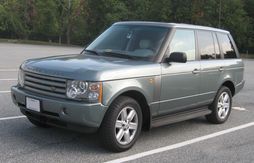
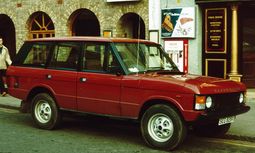
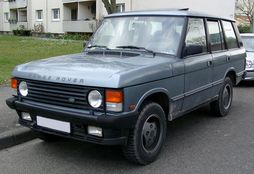
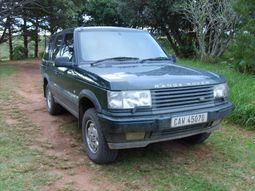
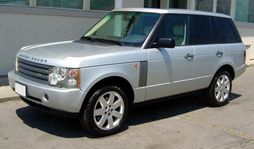
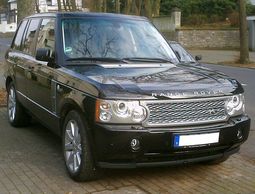
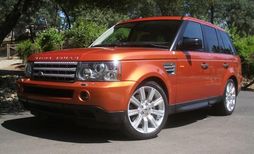
|